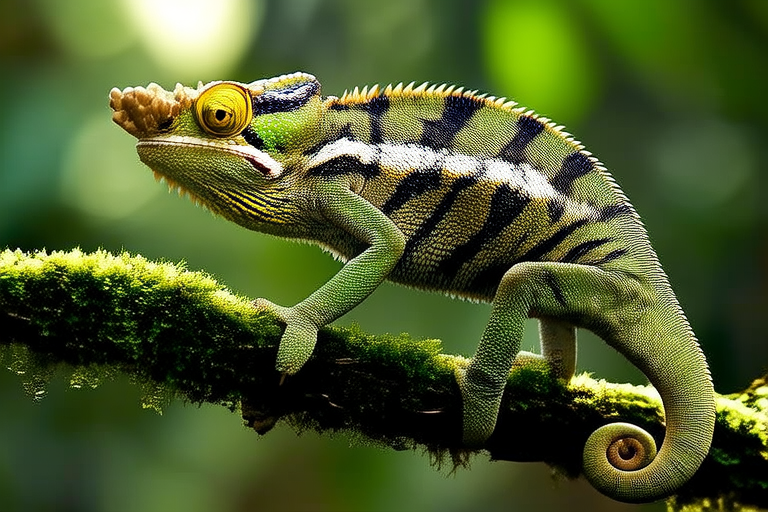Chameleon Secrets Unveiled: Discover the Hidden World of These Colorful Creatures
Chameleons, those enigmatic reptiles, have long captured human imagination with their extraordinary ability to change colors. These fascinating creatures belong to the family Chamaeleonidae and are known for their distinct physical characteristics and behaviors that set them apart from other reptiles. With over 200 species, chameleons are found across Africa, Madagascar, southern Europe, and parts of Asia. They range in size from the tiny Brookesia stump-tail chameleons, which measure just a few centimeters, to the massive Parson’s chameleon, reaching lengths of up to 68 cm.
The Science Behind Color Changes
Chameleons can alter their skin color through a complex system of specialized cells called chromatophores. These cells contain pigments that reflect light in different ways, allowing the chameleon to display a wide spectrum of colors. The process of changing color involves the interaction between three layers of chromatophores: xanthophores (yellow), erythrophores (red), and guanophores (blue). By expanding or contracting these layers, chameleons can produce a variety of hues and patterns.
Color changes serve multiple purposes. One of the most significant uses is communication. Males often change color to signal dominance or readiness to mate. During courtship, vibrant displays of color indicate health and vitality, while darker shades may be used to intimidate rivals. Additionally, chameleons employ color shifts for thermoregulation, absorbing more sunlight when they need to warm up and reflecting heat to cool down. Lastly, these reptiles utilize color changes for camouflage, blending seamlessly with their surroundings to avoid predators or sneak up on prey.
Habitats, Diet, and Behavior
Chameleons thrive in various environments, from lush rainforests to arid deserts. Their preferred habitats provide plenty of vegetation for cover and insects for sustenance. Most species are arboreal, spending much of their time high in trees, where they can bask in sunlight and hunt for food.
Their diet primarily consists of insects, such as crickets, locusts, and grasshoppers. Some larger species may also consume small birds, lizards, and even other chameleons. Chameleons are well-adapted hunters, relying on their long, sticky tongues, which can extend to twice their body length, to capture prey. This remarkable adaptation allows them to strike at insects from considerable distances.
Chameleons are also known for their distinctive eyes, which can rotate independently of each other, giving them nearly 360-degree vision. This unique feature aids in spotting potential threats or prey. Their feet are another intriguing aspect, featuring two toes pointing inward and three pointing outward, enabling them to grip branches firmly. Chameleons are generally solitary animals, only coming together during mating season.
Chameleon Care and Myths
For those interested in keeping chameleons as pets, it’s crucial to understand their specific needs. Captive environments should mimic their natural habitats, providing ample space, proper lighting, and appropriate temperatures. A balanced diet rich in nutrients is essential for maintaining their health. Common myths include the belief that chameleons change color solely to blend in with their surroundings. In reality, while camouflage is one reason for color changes, it’s not the primary purpose.
Another misconception is that chameleons require minimal care due to their self-sufficient nature. In reality, these reptiles have specific dietary and environmental requirements that must be met to ensure their well-being. Regular veterinary check-ups are recommended to monitor their health and address any issues promptly.
The Importance of Conservation
Despite their widespread appeal, many chameleon species face threats to their survival. Habitat destruction, illegal pet trade, and climate change pose significant challenges. Conservation efforts are vital in preserving these unique creatures and their ecosystems. By supporting protected areas, responsible breeding programs, and sustainable practices, we can help ensure the future of chameleons.
Encouraging public awareness and appreciation for chameleons is equally important. Educating others about the importance of these animals and the threats they face can inspire action and support for conservation initiatives. Every individual can contribute to protecting chameleons by supporting ethical pet stores, avoiding products made from endangered species, and advocating for stronger environmental policies.
In conclusion, chameleons are truly remarkable creatures with a wealth of fascinating traits and behaviors. Understanding their biology, ecology, and the challenges they face provides valuable insight into the world of these colorful reptiles. By appreciating and protecting chameleons, we can help ensure their continued existence and the preservation of the ecosystems they inhabit.
